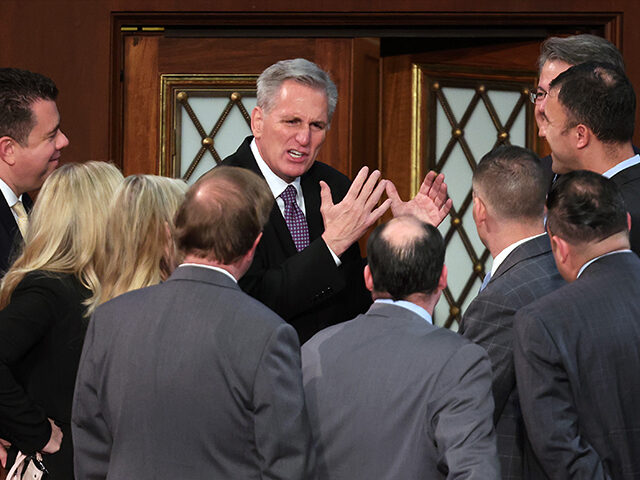What a difference a dozen years makes.
When Republicans took control over the House of Representatives during a Democratic presidency 12 years ago, they were riding the Tea Party wave of populist anger over bailouts. Yet despite a crowd of upstart newcomers, they managed to put on a united front when it came to electing the Speaker of the House. Rep. John Boehner (R-Ohio) won all of the GOP votes in the 112th Congress save one—his own, which he refused to cast for himself.
The Republican agenda at the time was infused with the Tea Party’s worry about debt and deficits that the U.S. government had taken on in the wake of the financial crisis and the Great Recession. Although President Barack Obama’s 2009 stimulus package looks quite modest by the standards of the spending undertaken during the pandemic and in the first year of the Biden administration, at the time it was widely viewed by Republicans and independents who regarded themselves as fiscally responsible as alarming.
To rein in spending, Republicans promised not to raise the debt ceiling unless it was paired with spending caps. This resulted in a summertime showdown between President Barack Obama and the Republicans that was—or at least appeared to be—wildly disruptive to financial markets. Between July 29 and August 8, the S&P 500 plunged 17 percent. Although the two sides were able to reach an agreement that suspended the ceiling, Standard & Poor’s expressed its disapproval over the debt ceiling fight by downgrading the credit rating of U.S. debt.

President Barack Obama speaks with House Speaker John Boehner during a meeting at the White House on July 23, 2011, about the debt ceiling. (JEWEL SAMAD/AFP via Getty Images)
Financial markets did not agree that the debt of the U.S. government had been shown by the fight to be riskier. Rather than plunging after the loss of the triple A rating, Treasury prices soared after the downgrade. Investors looked around at a world full of risk—European sovereigns were stumbling through their own debt crisis, for example—and decided they liked the safety of U.S. government bonds no matter what the S&P ratings folks said. Quite correctly, many viewed S&P’s ratings change as a political statement rather than an assessment of financial risk.
A friend at the time pointed out that it was, in fact, impossible for the U.S. government’s debt to be downgraded. The U.S. is the largest economy in the world, and the market for U.S. Treasuries is the largest financial market in the world. This means that Treasuries are—almost by definition—the safest financial assets in existence. Everything else is scaled off of U.S. government debt from slightly riskier to much, much riskier. If U.S. government debt becomes slightly riskier for some reason or another, every other financial instrument also becomes riskier. To paraphrase an old line of jokes about the Soviet Union: in the U.S., you don’t downgrade Treasuries. Treasuries downgrade you.
The current fight among Republican lawmakers over who will be Speaker of the House has implications for the debt ceiling debate we are likely to have later this year. The limit was raised in December of 2021 by $2.5 trillion to $31.381 trillion, which is expected to last until at least July of 2023. As we’ve learned in past episodes, that is hardly the end of the ability of the government to continue operations while revenue falls short of expenditures. The Treasury is able to engage in various “extraordinary measures” to stave off the need to issue debt for several months.
Wall Street and many Washington, D.C. political analysts are convinced that the Republicans will not “play chicken” with the debt ceiling this time around. After all, the GOP is increasingly dependent on senior citizen votes, and Democrats are sure to claim that the inability of the U.S. government to issue new debt will endanger Social Security and Medicaid. Many in the GOP leadership believe that the 2011 debt ceiling fight was not helpful to the party and may have contributed to the loss of the 2012 presidential election—despite overwhelming evidence that Mitt Romney and Paul Ryan were very effective at destroying GOP chances to win the White House all on their own.
Let us stipulate that the Republican House leadership have no stomach for a bloody debt limit fight. What the Speaker chaos is telling us is that that might not matter. There exists at least a vanguard of Republican Representatives who are spoiling for a fight, especially on issues of government spending. What’s more, in our age of rampant inflation, the case to rein in spending and deficits is far stronger than it was in 2011. If ever it made sense to listen to the constitution’s rule that debt must be authorized by Congress, it makes sense now that we’ve spent and borrowed our way into an inflation crisis.
Financial markets are currently blithely assuming that 2023 and 2024 will be years of legislative gridlock but not a near brush with a U.S. government legally barred from issuing debt to pay for authorized spending. At the very least, we think that’s currently an underpriced risk to markets.

COMMENTS
Please let us know if you're having issues with commenting.